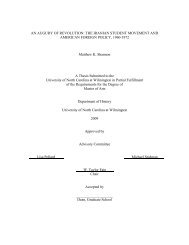HIERARCHAL INDUCTIVE PROCESS MODELING AND ANALYSIS ...
HIERARCHAL INDUCTIVE PROCESS MODELING AND ANALYSIS ...
HIERARCHAL INDUCTIVE PROCESS MODELING AND ANALYSIS ...
You also want an ePaper? Increase the reach of your titles
YUMPU automatically turns print PDFs into web optimized ePapers that Google loves.
Thus, using Proposition 1 we get,<br />
dN l<br />
= (a 21 − N l )a 22<br />
dt<br />
dN u<br />
+ N l a 22 = a 21 a 22<br />
dt<br />
N l (t) = a 21 + N 0 e −a 22t<br />
lim<br />
t→+∞ N l (t) = a 21<br />
To summarize the bounds,<br />
a 21 + N 0 e −a 22<br />
≤ N(t) ≤ γ N +<br />
(N 0 − γ N<br />
)<br />
e −a 22t<br />
When t → ∞ we obtain,<br />
∴ a 21 = 31 ≤ N(t) ≤ ∞ (28)<br />
Nitrate then has constant lower bound, which implies that the concentration will<br />
never go below a 21 for this particular model structure. This make us re-iterate that<br />
these models are very sensitive to parameter selection process. As mentioned above<br />
Iron as the same equation structures, thus using the same analysis we found Iron as<br />
follows:<br />
[<br />
] [<br />
dF<br />
dt = Da 17<br />
+<br />
(a 8 12.0107)<br />
[<br />
P<br />
−<br />
(a 8 12.0107)<br />
]<br />
E T H2 O<br />
(a 23 − F )a<br />
max<br />
− E T H2 O(t)<br />
24<br />
E T H2 O max<br />
− E T H2 O min<br />
[<br />
]<br />
(1 − E ice (t))a 0 e (0.06933∗E T H 2 O(t))<br />
M(t)<br />
]<br />
Thus,<br />
54
















